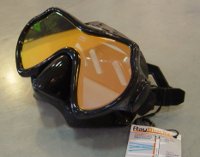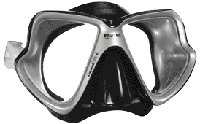Quick, name me the single most important piece of scuba equipment – I think we can all agree on the mask. Doesn’t matter how good the dive is, if you can’t see, what’s the point? The mask is pretty simple, not too expensive and pretty basic right? Think again …
Masks have come along way from a single piece of glass with a rubber skirt. Have you seen the old masks that don’t even have finger pockets, how do you get to you nose to equalize? (You shove the bottom of the skirt against the bottom of your nose, thus blocking the nostrils and allowing you to blow against it) Masks are way more comfy today with different sizes for different faces and softer silicone for a better fit.
But let’s talk about the latest and greatest. What have you done for me LATELY masks?
About 3 years ago, we saw new masks from Seadive that came with an anti-fog coating. Pretty cool, no more spitting in the mask for defog. The only problem is that the coating will eventually wear off.
Seadive also came out with different lenses. First came the Sharp Image Lens. This gave a slightly yellow tint to your view. It brightened up your vision and gave you better edge definition and depth perception. I used one of their Sea Venture masks with this lens for years. Unfortunately it was not a great seller and they discontinued it last year.
Next came out the True Color Lens. This gave a red tint to your vision. You know how you lose colors at depth and everything turns blueish? By adding red back to your vision you bring back the true colors. The only problem with this mask is that the tint makes it impossible to see the wearer’s eyes. The outside of the lens is like a mirror. You don’t realize how much you depend on seeing eyes to gauge someone’s mental state until you can’t see them. You have no way of telling if your buddy is ok, freaked out, paying attention or checking out the girl in the bikini in front of you! As an Instructor, I rely on eye contact to be able to judge how a student is feeling. Also it helps to be able to see when they are flooding and clearing their mask of water. I have no idea if the mask is still full or empty or what!
The next breakthrough in lenses came down to the glass being used. Seadive came out with Tru Vu lenses. During ordinary glass production, tiny metal particles remain within the glass and distort light passing through the lens. Also the impurities in standard glass tint the lens green blocking out true colors and distorting images especially in underwater low light conditions. Tru Vu lenses give you impurity free, ultra-clear, white light view.
 Lastly, they paired the Tru Vu lenses with a Rayblocker tint. The Rayblocker lens minimized harmful UV rays. They reduced the light wave lengths to the 400-600 nanometer range which is the most comfortable to our delicate eyes. The result is a very comfortable light that reaches our eyes.
Lastly, they paired the Tru Vu lenses with a Rayblocker tint. The Rayblocker lens minimized harmful UV rays. They reduced the light wave lengths to the 400-600 nanometer range which is the most comfortable to our delicate eyes. The result is a very comfortable light that reaches our eyes.
All of these masks with special lenses have black skirts. I have long been a big believer in black masks. I first tried one years ago because, well, they looked cool. Tec divers wear them and I wanted to look like a tec diver. One day, for a pool dive, I grabbed a clear mask off the rental wall. HOLY COW! Where did all this glare come from? Turns out clear masks let light through the skirt which reflects off the front lens causing some reflections and glare. You don’t really notice it until it’s gone and then if it comes back, it bugs the crap out of you! Black skirts on these masks are important because if you get light coming in, it will ruin the effect of the tint on the lens.
 Not to be out done, Mares entered the “cool new mask” competition 2 years ago with the Liquid Skin masks. Perhaps you have seen wetsuits that are made from super soft/stretchy neoprene. (Scubapro Everflex?) Mares has taken the same idea to mask skirts. All of today’s masks are a compromise between the need of a hard material to provide support to the frame and lenses and that of a soft material to adapt to the contours of the face and provide a good fit. Since skirts have been made of a single material, you needed to find the middle ground. Not any more. Mares uses Bi-silicone, a firmer portion for support (30% harder then what is used in a traditional mask) and a softer portion for contact with your face. The section that rests on your face is made with silicone that is 45% softer and 270% more elastic. This means a strong mask that feels great on your face. A softer nose pocket also means easier equalization. This is my current mask of choice.
Not to be out done, Mares entered the “cool new mask” competition 2 years ago with the Liquid Skin masks. Perhaps you have seen wetsuits that are made from super soft/stretchy neoprene. (Scubapro Everflex?) Mares has taken the same idea to mask skirts. All of today’s masks are a compromise between the need of a hard material to provide support to the frame and lenses and that of a soft material to adapt to the contours of the face and provide a good fit. Since skirts have been made of a single material, you needed to find the middle ground. Not any more. Mares uses Bi-silicone, a firmer portion for support (30% harder then what is used in a traditional mask) and a softer portion for contact with your face. The section that rests on your face is made with silicone that is 45% softer and 270% more elastic. This means a strong mask that feels great on your face. A softer nose pocket also means easier equalization. This is my current mask of choice.

 The last mask I want to talk about is the Aeris Compu mask. That’s right a computer built into the mask. If you haven’t been down to check this one out, then get in here. The mask has a slightly higher volume with a small screen built inside the mask in the lower left corner. This screen shows you depth, time and tank pressure. Yep, it’s air integrated as well. They recently lowered the price on the mask from $1500 to $1000 so it is a comparable price to other air-integrated hoseless computers.
The last mask I want to talk about is the Aeris Compu mask. That’s right a computer built into the mask. If you haven’t been down to check this one out, then get in here. The mask has a slightly higher volume with a small screen built inside the mask in the lower left corner. This screen shows you depth, time and tank pressure. Yep, it’s air integrated as well. They recently lowered the price on the mask from $1500 to $1000 so it is a comparable price to other air-integrated hoseless computers.
So if you’re in the market for a new mask, make sure to bring your nothing suit and c-card and jump in the pool to try out the latest and greatest in masks.
Let’s go diving!
Dave
Fall 2010


